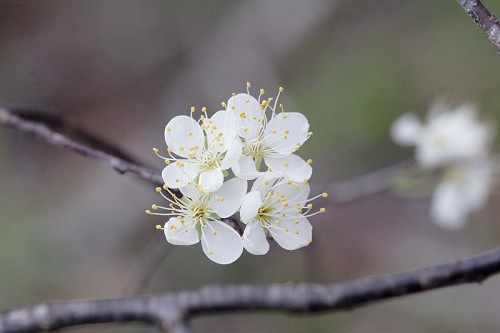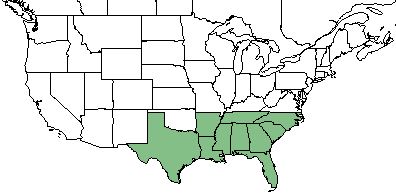Difference between revisions of "Prunus umbellata"
(→Taxonomic Notes) |
(→Habitat) |
||
| Line 32: | Line 32: | ||
==Ecology== | ==Ecology== | ||
===Habitat=== | ===Habitat=== | ||
| − | Habitats for ''P. umbellata'' include upland, sandy or rocky forests and woodlands.<ref name= | + | Habitats for ''P. umbellata'' include upland, sandy or rocky forests and woodlands.<ref name=weakley/> Specimens have been collected from loamy sands of disturbed areas, ridge thickets, pineoak woodland and along fencerow, old golf course, longleaf pine-oak woodland, hedgerow in field, upland pine woodland, mixed deciduous woodland, low shrub, quarry area, hammocks, beach ridge, and flodplain.<ref name = "FSU herbarium"> URL: http://herbarium.bio.fsu.edu. Last accessed: June 2018. Collectors: Loran C. Anderson, R.K. Godfrey, Delzie Demaree, John Nelson, Sidney McDaniel, Brenda Herring, Don Herring, L.G. Plank, H. Kurz, Robert Simmons, Bruce Hansen, Richard P. Wunderlin, Norma Mawhinney, Gary Knight, Patricia Elliot, Gwynn Ramsey, Richard Mitchell, D.L. Fichtner, L.J. Brass, O.Lakela, George M. Riegler, R. Komarek, Richard R. Clinebell II, Annie Schmidt, Richard Carter, Pat Ferral , Whit Gibbons. States and counties: Florida (Okaloosa, Franklin, Gulf, Leon, Gadsden, Jefferson, Jackson, Liberty, Madison, Bay, Columbia, Wakulla, Sumter, Washington, Lafayette, Suwannee, Dixie, Holmes, Highlands, Pasco) Georgia (Wheeler, Decatur, Grady, Thomas) SOuth Carolina (Orangeburg)</ref> |
<!--Natural communities, human disturbed habitats, topography, hydrology, soils, light, fire regime requirements for removal of competition, etc.--> | <!--Natural communities, human disturbed habitats, topography, hydrology, soils, light, fire regime requirements for removal of competition, etc.--> | ||
Latest revision as of 15:34, 14 July 2023
Common names: hog plum[1] , flatwoods plum[2]
| Prunus umbellata | |
|---|---|

| |
| Photo by John Gwaltney hosted at Southeastern Flora.com | |
| Scientific classification | |
| Kingdom: | Plantae |
| Division: | Magnoliophyta - Flowering plants |
| Class: | Magnoliopsida - Dicots |
| Order: | Rosales |
| Family: | Rosaceae |
| Genus: | Prunus |
| Species: | P. umbellata |
| Binomial name | |
| Prunus umbellata Elliott | |

| |
| Natural range of Prunus umbellata from USDA NRCS Plants Database. | |
Contents
Taxonomic Notes
Synonym: none[2]
Varieties; Prunus injucunda (Small); Prunus mitis (Beadle); P. umbellata Elliott; P. umbellata Elliott var. injuncunda (Small) Sargent; P. umbellata Elliott var. umbellata[2]
Description
P. umbellata is a perennial shrub/tree of the Rosaceae family that is native to North America.[1]
Distribution
P. umbellata is found throughout the southeastern United States; specifically, Florida, Georgia, South Carolina, North Carolina, Tennessee, Alabama, Mississippi, Louisiana, Arkansas, and Texas.[1]
Ecology
Habitat
Habitats for P. umbellata include upland, sandy or rocky forests and woodlands.[2] Specimens have been collected from loamy sands of disturbed areas, ridge thickets, pineoak woodland and along fencerow, old golf course, longleaf pine-oak woodland, hedgerow in field, upland pine woodland, mixed deciduous woodland, low shrub, quarry area, hammocks, beach ridge, and flodplain.[3]
Phenology
P. umbellata has been observed flowering January through April with peak inflorescence in March.[4]
Seed dispersal
This species is thought to be dispersed by consumption by vertebrates.[5]
Fire ecology
Prunus umbellata is more common in regions that are unburned;[6] however, populations have been known to persist through repeated annual burning.[7]
Herbivory and toxicology
Prunus umbellata has been observed to host true bugs such as Otiocerus sp. (family Derbidae).[8] Wildlife, particularly mammals, only use it for a small amount of their diets.[1]
Conservation, cultivation, and restoration
Cultural use
The plum fruit has long been eaten fresh or used in pies, jellies, sauces, and dried fruit.[9]
Photo Gallery
References and notes
- ↑ 1.0 1.1 1.2 1.3 USDA Plant Database
- ↑ 2.0 2.1 2.2 2.3 Weakley, A.S. 2020. Flora of the Southeastern United States. Edition of 20 October 2020. University of North Carolina at Chapel Hill, Chapel Hill, North Carolina.
- ↑ URL: http://herbarium.bio.fsu.edu. Last accessed: June 2018. Collectors: Loran C. Anderson, R.K. Godfrey, Delzie Demaree, John Nelson, Sidney McDaniel, Brenda Herring, Don Herring, L.G. Plank, H. Kurz, Robert Simmons, Bruce Hansen, Richard P. Wunderlin, Norma Mawhinney, Gary Knight, Patricia Elliot, Gwynn Ramsey, Richard Mitchell, D.L. Fichtner, L.J. Brass, O.Lakela, George M. Riegler, R. Komarek, Richard R. Clinebell II, Annie Schmidt, Richard Carter, Pat Ferral , Whit Gibbons. States and counties: Florida (Okaloosa, Franklin, Gulf, Leon, Gadsden, Jefferson, Jackson, Liberty, Madison, Bay, Columbia, Wakulla, Sumter, Washington, Lafayette, Suwannee, Dixie, Holmes, Highlands, Pasco) Georgia (Wheeler, Decatur, Grady, Thomas) SOuth Carolina (Orangeburg)
- ↑ Nelson, G. PanFlora: Plant data for the eastern United States with emphasis on the Southeastern Coastal Plains, Florida, and the Florida Panhandle. www.gilnelson.com/PanFlora/ Accessed: 24 MAY 2018
- ↑ Kirkman, L. Katherine. Unpublished database of seed dispersal mode of plants found in Coastal Plain longleaf pine-grasslands of the Jones Ecological Research Center, Georgia.
- ↑ Mehlman, D. W. (1992). "Effects of fire on plant community composition of North Florida second growth pineland." Bulletin of the Torrey Botanical Club 119(4): 376-383.
- ↑ Platt, W.J., R. Carter, G. Nelson, W. Baker, S. Hermann, J. Kane, L. Anderson, M. Smith, K. Robertson. 2021. Unpublished species list of Wade Tract old-growth longleaf pine savanna, Thomasville, Georgia.
- ↑ Discoverlife.org [1]
- ↑ Fernald, et al. 1958. Edible Plants of Eastern North America. Harper and Row Publishers, New York.